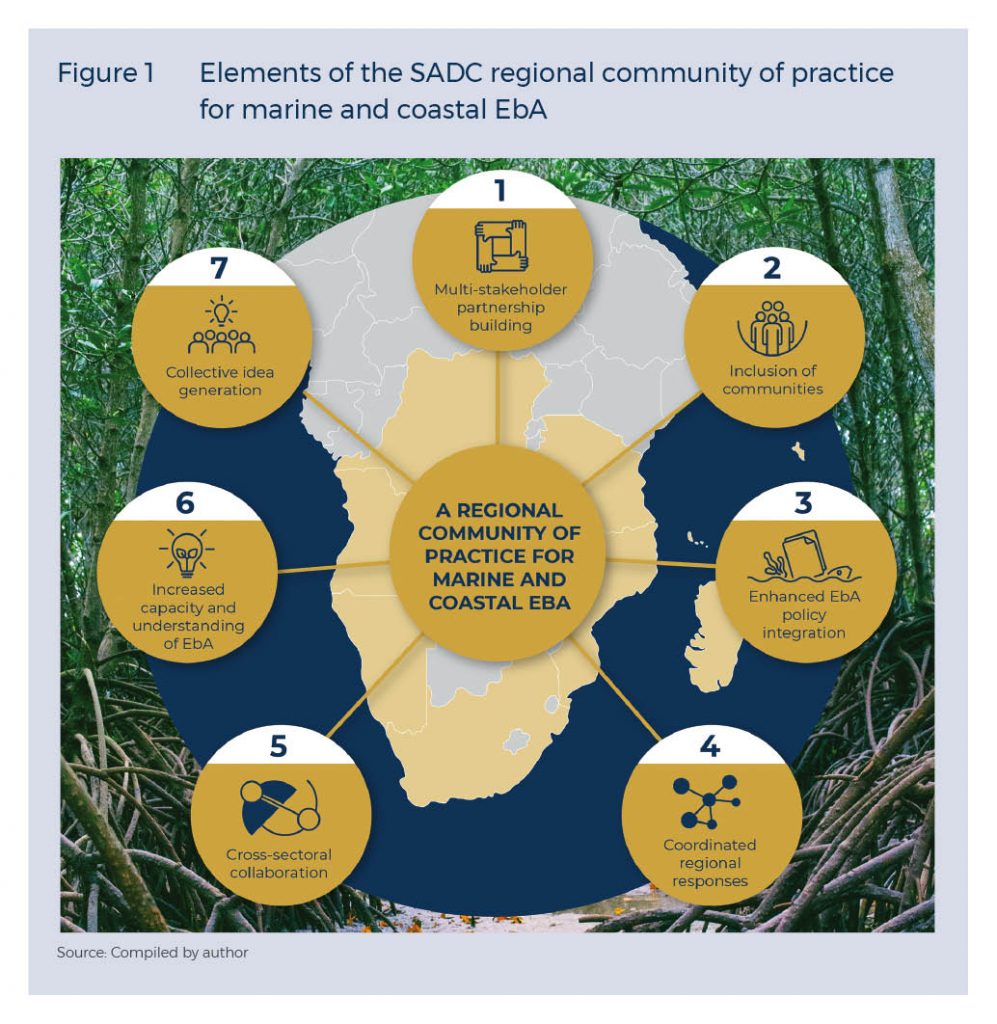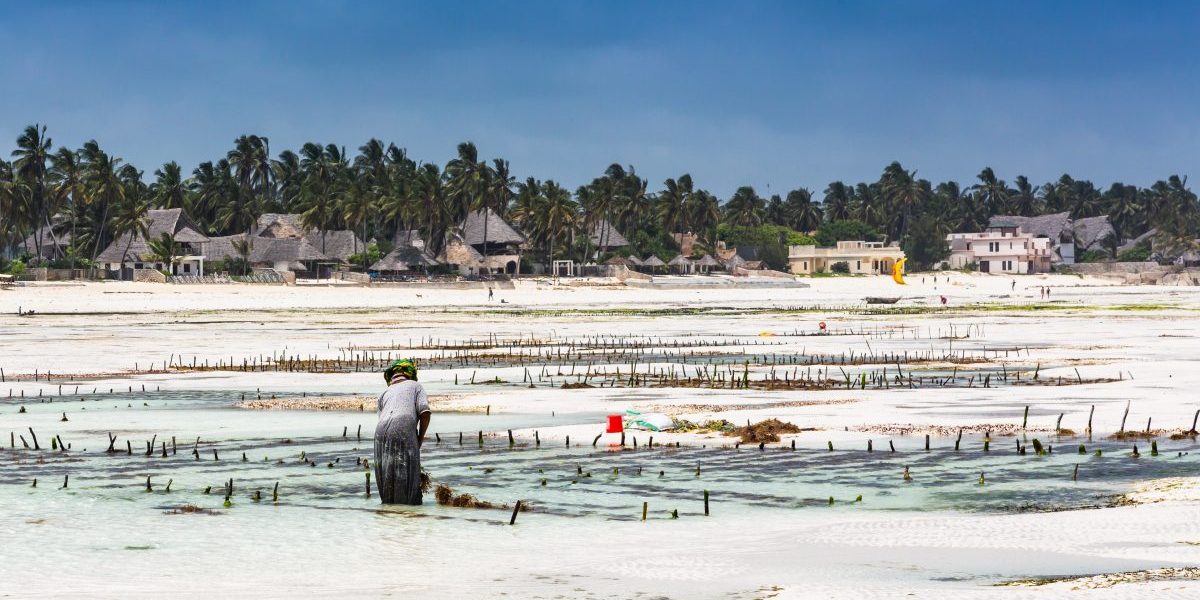Recommendations:
- SADC member states should integrate robust and timeframe-specific coastal and marine EbA targets in the upcoming 2025 NDC revision process.
- Climate, biodiversity and oceans-related policies should be aligned and should include EbA measures that can help accelerate the achievement of multiple policy objectives.
- Cooperative governance mechanisms should be established to strengthen collaboration between relevant ministries, as well as between national, provincial and local government in the area of marine and coastal EbA.
- SADC should lead the establishment of a regional EbA strategy that is responsive to the similarities and differences between all coastal and island states and pays special attention to the needs and vulnerabilities of coastal communities.
Download the Portuguese version of the publication here.
Download the French version of the publication here.
Executive summary
Coastal and island countries in Southern Africa are particularly vulnerable to the impacts of climate change. Ecosystem-based adaptation (EbA) is a viable and resource-efficient adaptation option, which, through the restoration of biodiversity, helps people to adapt to climate change. To enhance the climate resilience of coastal communities within SADC, EbA options for the coastal zone need to be integrated within climate change, biodiversity and oceans-related policies. Integrating targeted EbA interventions into national climate policy processes, including Nationally Determined Contributions (NDCs), will also help to accelerate the achievement of global climate and biodiversity goals set under the UN Framework Convention’s Paris Agreement, and the UN Convention for Biological Diversity’s (CBD) Kunming-Montreal Global Biodiversity Framework. While some SADC countries are making progress in this regard, several challenges that inhibit EbA uptake in the coastal zone still exist. This policy brief identifies these challenges and highlights the importance of the recently established regional community of practice to support cross-learning and best practice sharing between member states on EbA-related initiatives. Multi-stakeholder partnerships and cross-country collaboration will help to establish a regional vision for EbA in the coastal zones of SADC. This in turn will ensure that the most vulnerable communities in the coastal zone contribute to and meaningfully benefit from Southern Africa’s transition toward climate-resilient development.
Introduction
Countries in SADC 1SADC is an intergovernmental regional body consisting of 16 member states: Angola, Botswana, the Comoros, the Democratic Republic of the Congo (DRC), Eswatini, Lesotho, Madagascar, Malawi, Mauritius, Mozambique, Namibia, the Seychelles, South Africa, Tanzania, Zambia and Zimbabwe. are particularly vulnerable to the impacts of climate change, and this vulnerability is exacerbated by high levels of poverty, inequality and political instability. Coastal and island countries within the region, and specifically the coastal communities within these countries, are highly exposed to climate risks such as cyclones, floods and sea-level rise. Climate models have shown that the onset of such climate hazards is expected to increase in future years, which has been borne out by recent trends. For example, between 2021 and 2022, a total of six cyclones hit the SADC region, affecting over 2.5 million people.2Katonga Seyuba and Tània Ferré Garcia, “Climate-Related Security Risks in the SADC Region”, Stockholm International Peace Research Institute, November 23, 2022. To protect SADC coastal communities against the impacts of increased climate change, effective and resource-efficient adaption options need to be identified. This policy brief advocates for the upscaling of EbA as a means to enhance climate resilience while conserving biodiversity and promoting socio-economic development within SADC.
The need for healthy and resilient marine and coastal ecosystems in SADC
Coastal and marine environments are increasingly being recognised in climate policy owing to the important ecosystem services3Ecosystem services can be defined as the benefits people obtain from ecosystems and can be classified into four main categories: provisioning, regulating, cultural and supporting (Millennium Ecosystem Assessment, 2005). they provide, while supporting livelihoods and providing food for many people globally. Oceans cover approximately 72% of the earth’s surface, with about 40% of the world’s population living within 100km of the coastline.4UN Environmental Programme, Options for Ecosystem-based Adaptation (EBA) in Coastal Environments: A Guide for Environmental Managers and Planners (Nairobi: UNEP, 2016). Coastal environments, which lie at the interface between land and sea, also support a unique abundance of biodiversity and include both terrestrial ecosystems (eg, sand dunes) and marine habitats (eg, seagrass beds). Mangroves, which are found in tropical and subtropical coastal rivers, estuaries and bays, provide protection for communities against the onset of coastal storms. They also provide habitats for several species and are able to store up to five times as much organic carbon as tropical upland forests.5Mark Chatting et al., “Future Mangrove Carbon Storage Under Climate Change and Deforestation”, Frontiers in Marine Science 9 (2022): 1–14. Seagrass beds and kelp are also able to absorb and store carbon. Coral reefs protect coastal communities from storms and cyclones by significantly dampening wave energy.6Fillippo Ferrario et al., “The Effectiveness of Coral Reefs for Coastal Hazard Risk Reduction and Adaptation”, Nature Communications 5 (2014): 1–9. However, despite their importance, these ecosystems continue to be degraded and overexploited through pollution, overfishing and land conversion, as well as other destructive activities. A recent study by the University of Queensland found that only 15.5% of the world’s coastal regions remain ecologically intact.7Brooke A Williams et al., “Global Rarity of Intact Coastal Regions”, Conservation Biology 36 (2022): 1–12.
In SADC, coastal communities are particularly vulnerable to climate change, given their low levels of socio-economic development and high exposure to extreme weather events. These communities often have much lower adaptive capacity than people living further inland. Not only are they highly exposed to climate hazards such as cyclones, sea-level rise and coastal storms but they are also often heavily reliant on marine biodiversity for their livelihoods and food security. For example, in Mozambique, more than 350 000 people rely on the fishing sector for their livelihoods, with artisanal fishing representing about 90% of the annual fish production.8World Bank, Fisheries in Mozambique: A Snapshot (World Bank: Washington DC, 2021). In Madagascar, the fishing and aquaculture sector supports more than 1.5 million people, contributes more than 6.6% of total exports and makes up approximately 20% of the animal protein consumption by the Malagasy people.9World Bank, “Madagascar: Balancing Conservation and Exploitation of Fisheries Resources”, June 8, 2020. EbA interventions in the coastal zones of SADC can help to secure these livelihoods through interventions aimed at sustainable fisheries management, as well as the promotion of sustainable alternative livelihoods (eg, eco-tourism, beekeeping and mariculture).
Restoration activities such as planting mangroves and developing coral nurseries can also provide employment opportunities for community members. However, to ensure these opportunities are leveraged, there is a need to develop robust climate policies in the region that incorporate clear targets and timeframes for EbA implementation and promote multistakeholder partnerships that include communities.
Ecosystem-based adaptation in coastal and marine environments
The CBD defines EbA as ‘the use of biodiversity and ecosystem services as part of an overall climate adaptation strategy to help people adapt to the adverse effects of climate change’.10Secretariat of the Convention on Biological Diversity, Connecting Biodiversity and Climate Change Mitigation and Adaptation: Report of the Second Ad Hoc Technical Expert Group on Biodiversity and Climate Change, Technical Series 41 (Montreal: SCBD, 2009). EbA enhances the resilience of natural ecosystems, which improves their ability to provide ecosystem services. EbA is different from traditional adaptation approaches in that it contributes to three outcomes simultaneously, namely climate change adaptation, biodiversity conservation and socio-economic development. In this way, EbA can deliver a wide range of co-benefits to nature and society. EbA is often a more cost-effective form of adaptation compared to standard grey (engineered) options such as the construction of seawalls. This makes it an attractive option for countries with limited financial resources. EbA can also be implemented alongside engineered options in the form of hybrid solutions, eg, in Tanzania the government built a 2 400m concrete seawall while restoring 1 000ha of mangrove habitat and 2 000m² of coral reef.11Romy Chevallier, Marine and Coastal Ecosystem-based Adaptation for Enhanced Resilience in Southern Africa: Synthesis Report (Johannesburg: South African Institute of International Affairs, 2019).
In coastal environments, EbA can be implemented through a range of activities, such as mangrove and coral restoration, coastal wetland and dune conservation and rehabilitation, sustainable fisheries management, Marine Protected Areas (MPAs) and Locally Managed Marine Areas (LMMAs), coastal management lines, artificial reefs and the diversification and protection of ecosystem-related livelihoods. While these interventions each have their own unique properties, incorporating EbA measures into them means that more resilient natural ecosystems can better withstand climate shocks and protect coastal communities from these shocks. This ultimately results in better socio-economic development.
Many SADC countries are already implementing coastal EbA activities. For example, in Madagascar the coastal community network for LMMAs, MIHARI, together with the NGO Blue Ventures, has implemented the world’s largest community-led mangrove restoration project, which also generates carbon credits that are sold on the voluntary carbon market. Community networks such as Mwambao in Tanzania and Dahari in the Comoros are also working to protect and restore ecosystems in the coastal zone. In Cape Town, South Africa, dunes are being rehabilitated to protect coastal property owners against the onset of storm surges. The government of Mauritius is currently implementing a coastal rehabilitation programme that includes EbA measures such as planting endemic trees, which are better able to withstand climate shocks and provide protection against storms along the coast.
While there is growing evidence of EbA intervention in coastal environments within SADC, implementation is not without challenges. These include but are not limited to a lack of policy integration and poor governance, a lack of capacity and understanding of EbA, insufficient funding and a lack of access to finance, and the exclusion of communities from policy, planning and implementation.
Common challenges in implementing marine and coastal EbA in SADC
Policy and governance
Coastal and island countries in SADC are generally supported by robust climate policy frameworks. These frameworks, however, frequently lack the integration of EbA-specific interventions in the coastal zone. Certain countries are leading the development of EbA-related policy: eg, South Africa is currently revising its Strategic and Overarching Implementation Plan for EbA and Tanzania’s National Climate Change Strategy (2021–2026) sets out specific targets for mangrove restoration, diversified livelihoods in the coastal zone and the development of climate-informed fisheries management plans.12See Appendix 1 in Hannah Sack, A Regional Assessment of Marine and Coastal EbA in SADC, Special Report (Johannesburg: SAIIA, 2023) for a comparative policy assessment of marine and coastal EbA in SADC’s 10 coastal and island states. While six out of the 10 coastal and island countries in SADC 13The 10 coastal and island countries in SADC are South Africa, Namibia, Angola, Mozambique, Tanzania, the DRC, Comoros, Mauritius, Seychelles and Madagascar. specifically mention EbA/NbS in their NDCs, most fail to state clearly EbA-related targets for the coastal zone.
The siloed working nature of government departments also impedes EbA implementation, specifically in the coastal zone. Climate change units often sit within ministries of environment, which operate separately from ministries of fisheries or the blue economy. There is also often a disconnect between national ministries and local/provincial governments working on climate and coastal-related issues. This makes it difficult to assign responsibility for oversight and support to EbA initiatives within the coastal zone, which often involve the restoration or protection of biodiversity lying at the interface between land and sea.
Capacity and understanding EbA
Coastal planning is often done at the local level of government. Smaller municipalities, which tend to be under-capacitated and under-financed, lack the ability to manage and successfully implement climate change projects. This results in unequal distribution of effective coastal resource management within a country. A lack of EbA monitoring and evaluation skills, coupled with high staff turnover rates, also impedes EbA implementation at the local level.14Hannah Reid et al., Is Ecosystem-Based Adaptation Effective? Perceptions and Lessons Learned from 13 Project Sites, Research Report (London: International Institute for Environment and Development, 2019). EbA is a fairly new concept and has only recently been mainstreamed into some countries’ climate policy and planning. It is therefore important that EbA training and capacity building for government, environmental practitioners and community members be increased throughout the region to help upscale climate-resilient coastal development.
Finance
Financing for adaptation is well below the volumes required for Africa.15Olivia Rumble, “The Road to COP27: Africa’s Adaptation Finance Agenda”, SAIIA, Opinions and Analysis, August 11, 2022. In addition, a lack of clear targets and time frames for coastal and marine EbA within climate policies and NDCs impedes SADC countries’ ability to attract donor funding for related initiatives. While most EbA initiatives have been funded by government, budgetary constraints and high rates of poverty and inequality mean that this funding is insufficient. Countries also pursue economic growth and, once they upgrade their economic status, are no longer eligible for concessional finance.16Angelique Pouponneau, “Financing EbA for Marine and Coastal Resources” (Occasional Paper 342, SAIIA, Johannesburg, 2023). This is particularly concerning for small island developing states in the region, which require large sums of coastal adaptation finance. However, despite these challenges, SADC countries have implemented a few successful, innovative financing models for EbA. These include the Seychelles Debt-for-Nature Swap and Blue Bond, payment for ecosystem services in certain coastal zones, and the sale of blue carbon credits through mangrove restoration in Madagascar.17Please see Sack, A Regional Assessment, for full details.
Community participation and inclusion
EbA initiatives along the coastal zone require the inclusion and participation of communities that rely directly on coastal natural resources for their livelihoods. Top-down approaches, where government or NGOs implement restoration activities and place restrictions on activities such as fishing and mangrove harvesting without actively engaging or even consulting communities, are unlikely to be accepted by these communities. Special care must be taken to ensure that the voices of vulnerable groups, such as women and youth, are brought into EbA initiatives and policy processes. It is important that coastal community livelihoods are safeguarded through the implementation of sustainable management approaches. This can be seen in the temporary octopus closure models in Tanzania, Comoros and Madagascar, as well as the promotion of sustainable alternative livelihoods such as seaweed harvesting, sea-cucumber farming, climate-smart agriculture and beekeeping.
Towards a SADC regional community of practice for marine and coastal EbA
While each of the coastal and island countries within SADC are unique and have different kinds of biodiversity along their coastlines, many share similar characteristics and require transboundary management of resources. Regional bodies such as the Benguela Current Convention, which governs the Benguela Large Marine Ecosystem of Angola, Namibia and South Africa, and the Nairobi Convention, a regional treaty that works to protect, develop and manage the Western Indian Ocean,18Contracting parties to the Nairobi Convention include Comoros, France, Kenya, Madagascar, Mauritius, Mozambique, South Africa, Seychelles, Somalia and Tanzania. play key roles in advancing regional cooperation for marine resources in SADC. There is still a need, however, to establish a dedicated platform for knowledge sharing and best-practice learning between SADC member states that can help to advance the implementation of regional strategies such as the SADC Regional Indicative Strategic Development Plan 2020–2030 and the SADC Climate Change Strategy and Action Plan (2020–2030).

Strengthening regional networks for marine and coastal EbA can accelerate lessonsharing and replication of EbA best-practice initiatives while enhancing collaboration and partnership building to help upscale the integration of EbA into policy as well as on-theground implementation. As part of the project ‘Strengthening Marine and Coastal EbA in the National Climate Responses of SADC’s Coastal States’, under the Global Climate Change Alliance Plus (GCCA+) programme, SAIIA has established a SADC regional community of practice for marine and coastal EbA. This includes multiple stakeholders such as policymakers, academia, NGOs, private sector, community-based organisations and women and youth representatives. It is aimed at encouraging inclusivity in policymaking and EbA design, while ensuring the most pressing needs of vulnerable people in the region are brought to the forefront in discussions.19Individuals or institutions interested in joining the community of practice can reach out directly to SAIIA or engage through the community’s group page on LinkedIn, ‘Marine and Coastal Ecosystem-based Adaptation – Southern Africa Community of Practice’. The establishment of this platform will also create an opportunity to form global partnerships and inform global best practice through networks such as the Friends of EbA Network and the International EbA community of practice.
Conclusion
While EbA policy and implementation is gaining traction in SADC, there is a need to further upscale existing initiatives and design new innovative initiatives that can be replicated at scale. Countries in the region need to work together to align their interests and to procure the necessary finance to support EbA implementation. The development of a SADC resource mobilisation plan for climate-resilient development could help to pool resources from various sources and create political will for EbA. Formalising EbA champions in each SADC country and establishing regional engagements for lesson and best practice sharing can also enhance national uptake of EbA initiatives while supporting regional cooperation between member states. In addition, SADC countries should seek to align their climate, biodiversity and oceans policies by integrating EbA measures into national and local policy processes. EbA policy development and implementation also need to ensure that communities, youth and women are included, and that their needs are well represented. This in turn will ensure that the most vulnerable communities in the coastal zone are accounted for in Southern Africa’s transition toward climate-resilient development.
Acknowledgement
This publication has been produced through the ‘Strengthening marine and coastal ecosystem-based adaptation (EbA) in the national climate responses of SADC’s coastal states’ project, which was implemented under the Global Climate Change Alliance Plus (GCCA+) programme and overseen by the SADC Secretariat. A SADC regional community of practice on marine and coastal ecosystem-based adaptation was also established through this project. Please contact SAIIA’s Climate and Natural Resources Programme for more details.
Listen:








